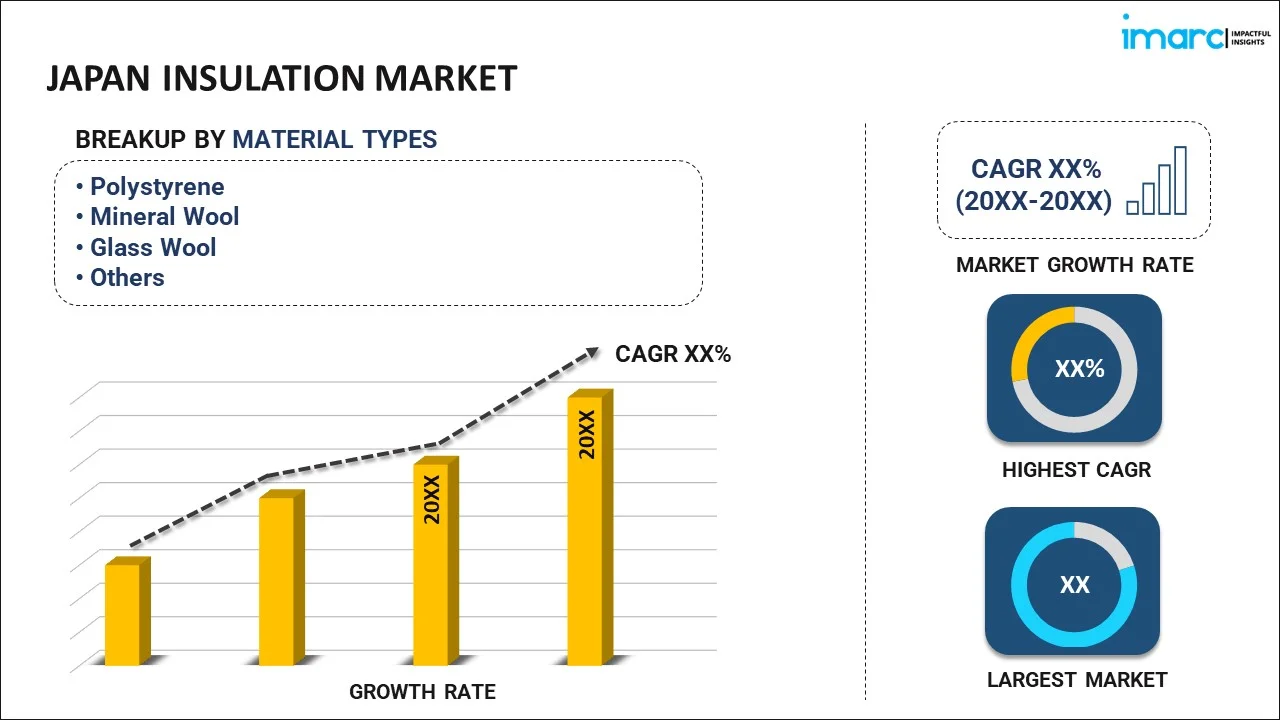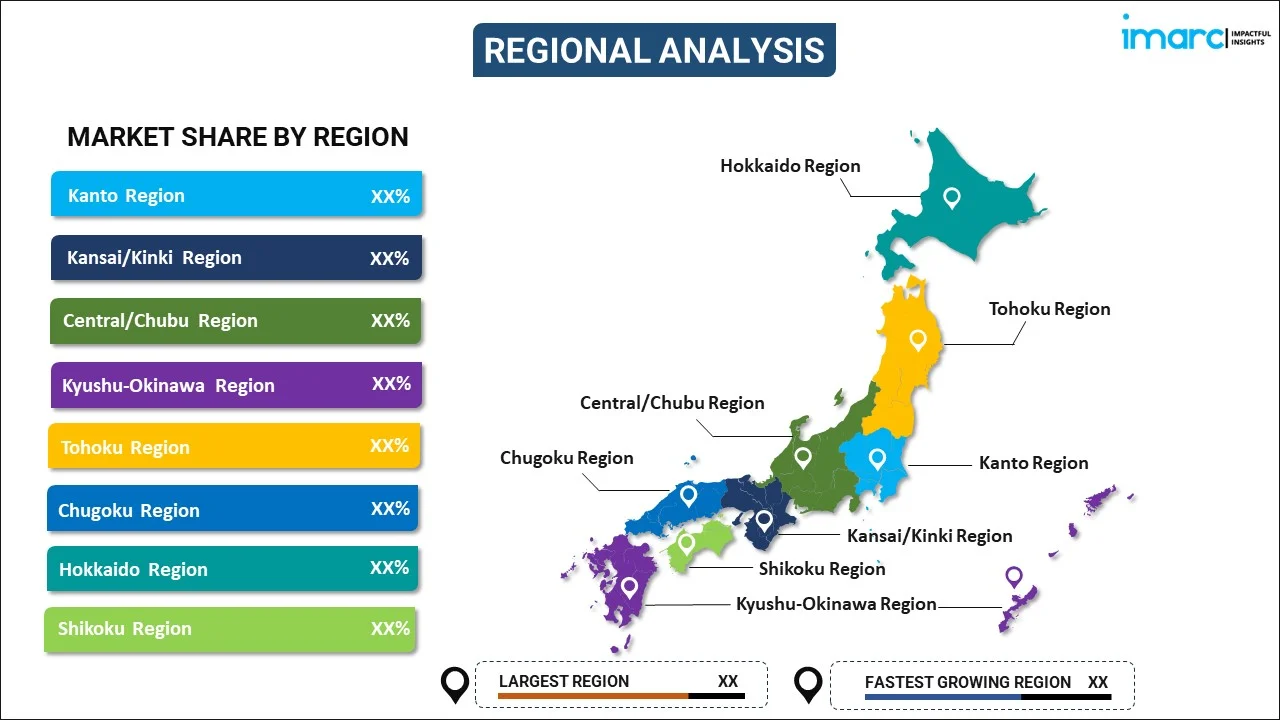
Japan Insulation Market Report by Material Type (Polystyrene, Mineral Wool, Glass Wool, Polyurethane, Calcium Silicate, and Others), Function (Thermal, Acoustic, Electric, and Others), Form (Blanket, Foam, Board, Pipe, and Others), End Use Industry (Non-Residential, Residential, Industrial and Plant Equipment, HVAC Equipment, Appliances, Transport Equipment, and Others), and Region 2025-2033
Market Overview:
Japan Insulation market size reached USD 2.5 Billion in 2024. Looking forward, IMARC Group expects the market to reach USD 4.6 Billion by 2033, exhibiting a growth rate (CAGR) of 6.27% during 2025-2033. The growing focus of Japan on energy efficiency and sustainability, the implementation of government initiatives and incentives to encourage the adoption of insulation, and the increasing awareness regarding the benefits of insulation represent some of the key factors driving the market.
|
Report Attribute
|
Key Statistics
|
|---|---|
|
Base Year
|
2024 |
|
Forecast Years
|
2025-2033
|
|
Historical Years
|
2019-2024
|
| Market Size in 2024 | USD 2.5 Billion |
| Market Forecast in 2033 | USD 4.6 Billion |
| Market Growth Rate (2025-2033) | 6.27% |
Insulation refers to the material or system used to reduce the transfer of heat, cold, or sound between several areas or spaces. It maintains a comfortable indoor environment by preventing the unwanted exchange of thermal energy. It works by slowing down the movement of heat through conduction, convection, and radiation. Conduction involves the transfer of heat through solid materials, such as walls, floors, and roofs. Effective insulation materials, including fiberglass, foam board, or cellulose, are poor conductors of heat and help to inhibit this transfer. Additionally, convection is the movement of heat through liquids or gases, including air. Insulation materials create barriers that reduce the circulation of air, thereby minimizing heat exchange, while radiation refers to the emission of heat in the form of infrared energy. Reflective materials, including foil-backed insulation, can reflect this energy back into the space, further enhancing thermal resistance. It also improves energy efficiency, reduces heating and cooling costs, helps maintain a consistent temperature, and enhances comfort year-round. Nowadays, insulation is widely adopted in various settings, including vehicles, appliances, and residential, commercial, and industrial buildings across the region.
Japan Insulation Market Trends:
The market is primarily driven by the rising focus of Japan on energy efficiency and sustainability in recent years. In addition, the growing concern for environmental issues and the need to reduce energy consumption are escalating the demand for insulation materials that enhance energy efficiency, influencing the market growth. As a result, businesses and homeowners are seeking insulation solutions to reduce their energy consumption and carbon footprint. Moreover, the growing infrastructure is driving the insulation market growth, as older buildings in the country lack proper insulation, leading to energy wastage and discomfort for occupants, which is creating a substantial market for retrofitting insulation solutions in existing buildings to improve thermal performance and comfort, representing another major growth-inducing factor. Besides this, the implementation of government initiatives and incentives is encouraging the adoption of insulation in residential and commercial construction with various programs, such as subsidies and tax benefits, incentivizing property owners to invest in energy-efficient upgrades, including insulation, accelerating the market growth. Along with this, manufacturers are continually developing innovative insulation materials that offer improved performance, durability, and ease of installation, propelling the market growth. Furthermore, the increasing awareness of the benefits of insulation allowed individuals to be more informed about how insulation can help maintain a comfortable indoor environment year-round, reducing the need for excessive heating or cooling and shifting consumer preferences toward more energy-efficient and insulated homes, creating a positive market outlook.
Japan Insulation Market Segmentation:
IMARC Group provides an analysis of the key trends in each segment of the market, along with forecasts at the country level for 2025-2033. Our report has categorized the market based on material type, function, form, and end use industry.
Material Type Insights:

- Polystyrene
- Mineral Wool
- Glass Wool
- Polyurethane
- Calcium Silicate
- Others
The report has provided a detailed breakup and analysis of the market based on the material type. This includes polystyrene, mineral wool, glass wool, polyurethane, calcium silicate, and others.
Function Insights:
- Thermal
- Acoustic
- Electric
- Others
A detailed breakup and analysis of the market based on the function have also been provided in the report. This includes thermal, acoustic, electric, and others.
Form Insights:
- Blanket
- Foam
- Board
- Pipe
- Others
The report has provided a detailed breakup and analysis of the market based on the form. This includes blanket, foam, board, pipe, and others.
End Use Industry Insights:
- Non-Residential
- Residential
- Industrial and Plant Equipment
- HVAC Equipment
- Appliances
- Transport Equipment
- Others
A detailed breakup and analysis of the market based on the end use industry have also been provided in the report. This includes non-residential, residential, industrial and plant equipment, HVAC equipment, appliances, transport equipment, and others.
Regional Insights:

- Kanto Region
- Kansai/Kinki Region
- Central/ Chubu Region
- Kyushu-Okinawa Region
- Tohoku Region
- Chugoku Region
- Hokkaido Region
- Shikoku Region
The report has also provided a comprehensive analysis of all the major regional markets, which include Kanto Region, Kansai/Kinki Region, Central/ Chubu Region, Kyushu-Okinawa Region, Tohoku Region, Chugoku Region, Hokkaido Region, and Shikoku Region.
Competitive Landscape:
The market research report has also provided a comprehensive analysis of the competitive landscape in the market. Competitive analysis such as market structure, key player positioning, top winning strategies, competitive dashboard, and company evaluation quadrant has been covered in the report. Also, detailed profiles of all major companies have been provided.
Japan Insulation Market Report Coverage:
| Report Features | Details |
|---|---|
| Base Year of the Analysis | 2024 |
| Historical Period | 2019-2024 |
| Forecast Period | 2025-2033 |
| Units | Billion USD |
| Scope of the Report | Exploration of Historical and Forecast Trends, Industry Catalysts and Challenges, Segment-Wise Historical and Predictive Market Assessment:
|
| Material Types Covered | Polystyrene, Mineral Wool, Glass Wool, Polyurethane, Calcium Silicate, Others |
| Functions Covered | Thermal, Acoustic, Electric, Others |
| Forms Covered | Blanket, Foam, Board, Pipe, Others |
| End Use Industries Covered | Non-Residential, Residential, Industrial and Plant Equipment, HVAC Equipment, Appliances, Transport Equipment, Others |
| Regions Covered | Kanto Region, Kansai/Kinki Region, Central/ Chubu Region, Kyushu-Okinawa Region, Tohoku Region, Chugoku Region, Hokkaido Region, Shikoku Region |
| Customization Scope | 10% Free Customization |
| Post-Sale Analyst Support | 10-12 Weeks |
| Delivery Format | PDF and Excel through Email (We can also provide the editable version of the report in PPT/Word format on special request) |
Key Questions Answered in This Report:
- How has the Japan insulation market performed so far and how will it perform in the coming years?
- What has been the impact of COVID-19 on the Japan insulation market?
- What is the breakup of the Japan insulation market on the basis of material type?
- What is the breakup of the Japan insulation market on the basis of function?
- What is the breakup of the Japan insulation market on the basis of form?
- What is the breakup of the Japan insulation market on the basis of end use industry?
- What are the various stages in the value chain of the Japan insulation market?
- What are the key driving factors and challenges in the Japan insulation?
- What is the structure of the Japan insulation market and who are the key players?
- What is the degree of competition in the Japan insulation market?
Key Benefits for Stakeholders:
- IMARC’s industry report offers a comprehensive quantitative analysis of various market segments, historical and current market trends, market forecasts, and dynamics of the Japan insulation market from 2019-2033.
- The research report provides the latest information on the market drivers, challenges, and opportunities in the Japan insulation market.
- Porter's five forces analysis assist stakeholders in assessing the impact of new entrants, competitive rivalry, supplier power, buyer power, and the threat of substitution. It helps stakeholders to analyze the level of competition within the Japan insulation industry and its attractiveness.
- Competitive landscape allows stakeholders to understand their competitive environment and provides an insight into the current positions of key players in the market.
Need more help?
- Speak to our experienced analysts for insights on the current market scenarios.
- Include additional segments and countries to customize the report as per your requirement.
- Gain an unparalleled competitive advantage in your domain by understanding how to utilize the report and positively impacting your operations and revenue.
- For further assistance, please connect with our analysts.
 Request Customization
Request Customization
 Speak to an Analyst
Speak to an Analyst
 Request Brochure
Request Brochure
 Inquire Before Buying
Inquire Before Buying




.webp)




.webp)












